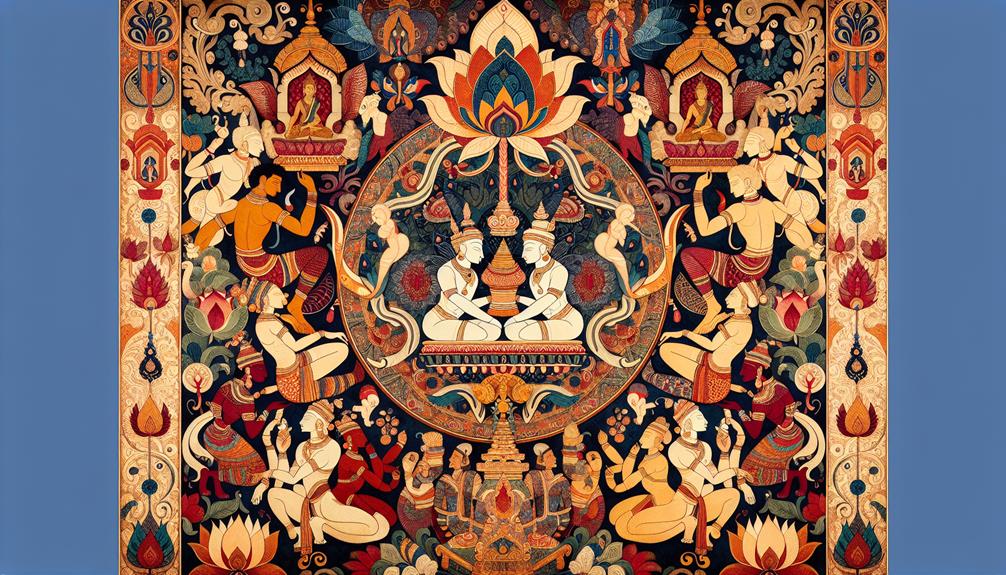What Is The Origin Of The Kama Sutra
The origins of the Kama Sutra, a text synonymous with love, intimacy, and pleasure, trace back to ancient India. Yet, unraveling the precise genesis of this revered work proves to be a complex endeavor.
What Is The Origin Of The Kama Sutra
From the authorship conundrum to its historical context and cultural impact, the Kama Sutra's journey through time is a labyrinth of intrigue.
What Is The Origin Of The Kama Sutra
Exploring how this ancient treatise on the art of living and loving has transcended boundaries and influenced diverse societies could offer fascinating insights into its enduring allure and relevance even in the contemporary world.
What Is The Origin Of The Kama Sutra
Key Takeaways
- The Kama Sutra originates from ancient India, attributed to sage Vatsyayana in the 2nd century CE.
- Its influence on Indian society includes shaping perceptions of intimacy, relationships, and promoting mutual respect.
- The text's transmission to the West marked a milestone in East-West knowledge exchange, impacting Western perceptions.
- Modern reinterpretations emphasize emotional connections, influencing societal views on intimacy and relationships.
Ancient Indian Origins
The Kama Sutra, an ancient Indian text on human sexual behavior and relationships, has its origins deeply rooted in the cultural and philosophical landscape of ancient India. Dating back to the 2nd century CE, this influential text is attributed to the sage Vatsyayana. The Kama Sutra delves into various aspects of relationships, from courtship to intimacy, highlighting the importance of mutual respect and understanding between partners.
What Is The Origin Of The Kama Sutra
In ancient India, the pursuit of kama, or sensual pleasure, was considered one of the essential goals of human life, alongside dharma (duty), artha (material prosperity), and moksha (spiritual liberation). The Kama Sutra not only provides guidance on physical intimacy but also emphasizes the significance of emotional connection and communication in fostering fulfilling relationships.
What Is The Origin Of The Kama Sutra
Through its detailed descriptions and philosophical insights, the Kama Sutra reflects the values and beliefs of ancient Indian society, offering a holistic approach to human relationships that continues to resonate with readers seeking a deeper understanding of love, intimacy, and connection.
What Is The Origin Of The Kama Sutra
Authorship and Historical Context
Vatsyayana, the attributed sage behind the Kama Sutra, lived during a significant period in ancient Indian history marked by rich cultural and philosophical developments. His authorship and the historical context in which he existed provide valuable insights into the creation and significance of this renowned text.
What Is The Origin Of The Kama Sutra
Authorship and Historical Context:
- Vatsyayana's Identity: Vatsyayana is believed to have been a scholar from ancient India, well-versed in various subjects like philosophy, arts, and literature. His precise identity and life details remain somewhat mysterious, adding an air of intrigue to the Kama Sutra's origins.
- Cultural Milieu: The era in which Vatsyayana lived was characterized by a flourishing of arts, literature, and intellectual pursuits. This vibrant cultural backdrop likely influenced the content and tone of the Kama Sutra.
- Philosophical Underpinnings: Vatsyayana's work reflects the philosophical ideas prevalent during his time, emphasizing not just physical pleasure but also spiritual connection and holistic well-being in human relationships.
Influence on Indian Society
With its profound insights into human relationships and intimate connections, the Kama Sutra has left a lasting impact on Indian society. This ancient text has influenced various aspects of Indian culture, shaping societal norms, attitudes towards relationships, and perceptions of intimacy. One of the key contributions of the Kama Sutra to Indian society is its emphasis on the importance of mutual respect, understanding, and communication in relationships. This has helped foster healthier and more fulfilling connections between individuals.
To further understand the influence of the Kama Sutra on Indian society, let's explore a comparison between traditional societal views and those influenced by the text:
| Traditional Views | Kama Sutra Influenced Views |
|---|---|
| Arranged marriages were common | Emphasis on mutual attraction and compatibility |
| Limited discussion on intimacy | Encourages open communication about desires and pleasure |
| Gender roles were strictly defined | Advocates for equality and mutual satisfaction in relationships |
| Taboo around discussing sexual preferences | Normalizes the exploration of desires and preferences |
| Hierarchical relationships | Promotes mutual respect and understanding between partners |
Transmission to the West
Having traversed cultural boundaries, the dissemination of the Kama Sutra to the West marked a significant milestone in the exchange of knowledge and ideas. The transmission of this ancient Indian text to Western societies occurred through various channels, each playing a role in shaping its reception and impact:
- Colonial Encounters: During the colonial era, European travelers and officials in India encountered the Kama Sutra and other Indian texts on human sexuality. These encounters led to translations and interpretations being brought back to Europe.
- Literary Circles: In the 19th and early 20th centuries, the Kama Sutra gained popularity among European literary circles fascinated by exotic Eastern cultures. This interest sparked discussions and debates on sexuality, relationships, and cultural differences.
- Modern Publishing: With the rise of globalization and the internet, the Kama Sutra has become widely available in the West through modern publishing, online platforms, and popular culture references, contributing to its enduring legacy and influence on Western perceptions of love and intimacy.
Modern Reinterpretations and Impact
In contemporary times, the Kama Sutra has undergone modern reinterpretations that continue to influence societal perceptions and practices related to intimacy and relationships. While historically seen as a manual for sexual positions, the modern understanding of the Kama Sutra has evolved to emphasize emotional connection, communication, and consent within intimate relationships. This shift in focus has contributed to a more holistic view of intimacy, highlighting the importance of mutual respect and understanding between partners.
Furthermore, the Kama Sutra's influence can be seen in various aspects of popular culture, from books and movies to relationship advice columns. Many modern interpretations draw upon the ancient text's teachings on sensuality and pleasure, encouraging individuals to explore their desires and deepen their connections with others. This reimagining of the Kama Sutra has sparked conversations about sexuality and relationships, promoting open dialogue and a more inclusive approach to intimacy.
Frequently Asked Questions
What Are Some Common Misconceptions About the Kama Sutra?
Common misconceptions about the Kama Sutra often revolve around its sole focus on sexual positions. In reality, the text encompasses a wide range of topics beyond physical intimacy, including relationships, emotions, and societal norms.
Another misconception is that it is a pornographic manual when, in fact, it is a philosophical guide that promotes love, respect, and mutual understanding between partners. Understanding these nuances is key to appreciating the true essence of the Kama Sutra.
Are There Any Controversies Surrounding the Interpretation or Translation of the Kama Sutra?
Interpretation controversies shroud the Kama Sutra, creating a tapestry of debate among scholars. The nuances of translating ancient texts often evoke a symphony of varied perspectives, akin to deciphering a cryptic code.
In this realm, the Kama Sutra stands as a vivid example of the challenges posed by linguistic intricacies and cultural biases. As such, navigating the labyrinth of interpretations requires a keen eye and a scholarly spirit to unravel its profound meanings.
How Has the Perception of the Kama Sutra Evolved Over Time?
The perception of the Kama Sutra has evolved significantly over time, transitioning from a misunderstood erotic manual to a revered text on love, relationships, and spirituality.
Initially seen through a narrow lens as merely a guide to sexual positions, modern interpretations emphasize its broader teachings on intimacy, communication, and emotional connection.
This evolution reflects society's shifting attitudes towards sexuality, highlighting the text's enduring relevance in exploring human relationships.
What Role Did Women Play in the Creation and Dissemination of the Kama Sutra?
Women played a significant role in the creation and dissemination of the Kama Sutra. While historically overshadowed, recent scholarship highlights their involvement in shaping this influential text.
Women's perspectives and contributions provided crucial insights into the complexities of human relationships and sexuality. Their presence in the development and transmission of the Kama Sutra underscores the importance of recognizing their agency and expertise in matters of intimacy and pleasure.
Are There Any Specific Rituals or Practices Associated With the Use of the Kama Sutra in Ancient Indian Society?
Rituals and practices associated with the Kama Sutra in ancient Indian society were deeply intertwined with cultural beliefs and societal norms.
The text served not only as a guide to intimate relationships but also as a manual for virtuous living.
Rituals such as meditation, cleanliness, and mutual respect were emphasized to cultivate a harmonious connection between partners.
These practices aimed to elevate physical intimacy to a spiritual and sacred level within the context of Indian society.
Conclusion
In conclusion, the Kama Sutra, like a well-traveled road, has journeyed through ancient Indian origins, authorship, and transmission to the West, influencing societies along the way.
Its modern reinterpretations continue to shape perceptions of love, relationships, and sexuality. Its impact remains profound and enduring, like a ripple effect spreading across cultures and generations.

